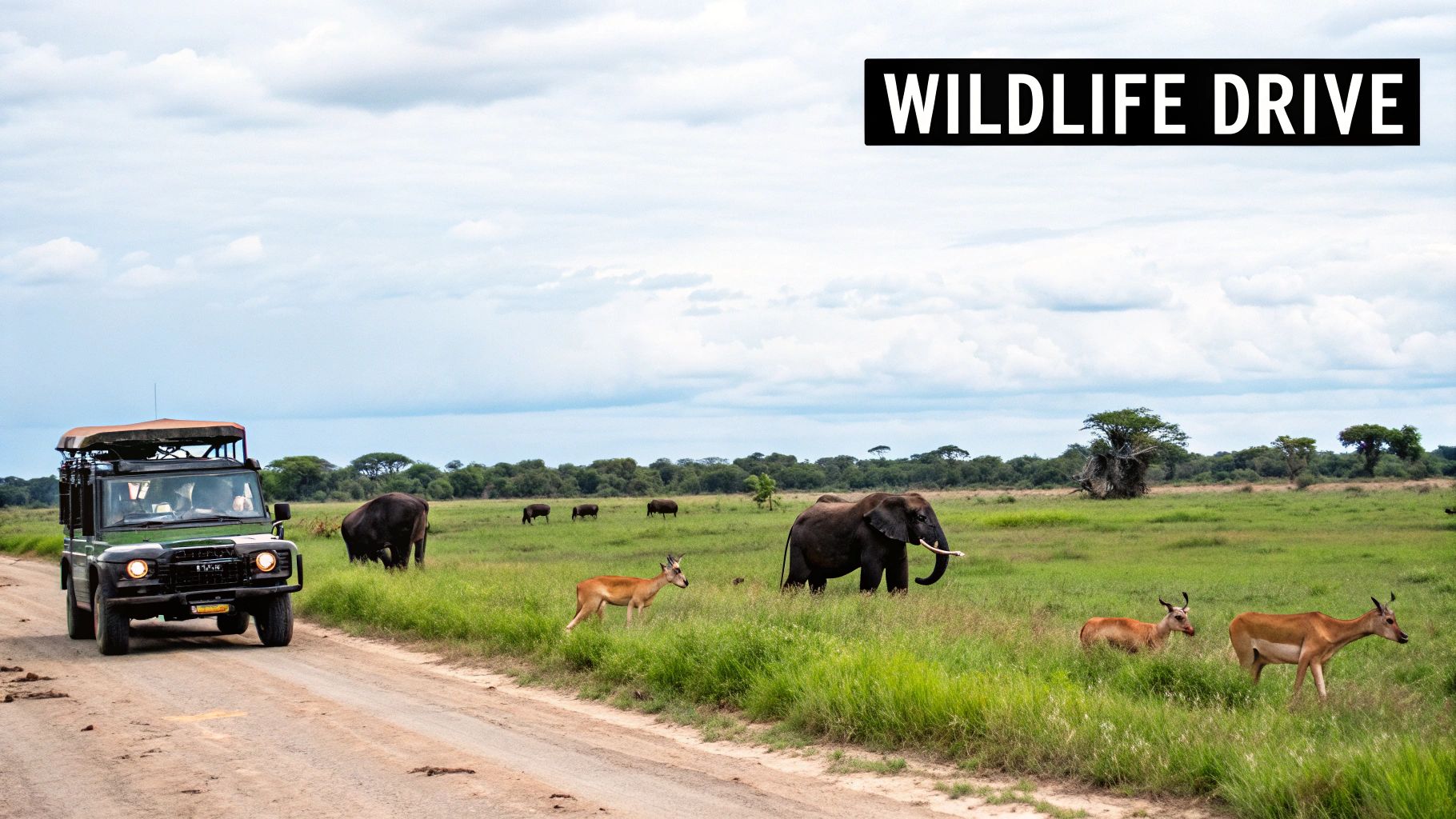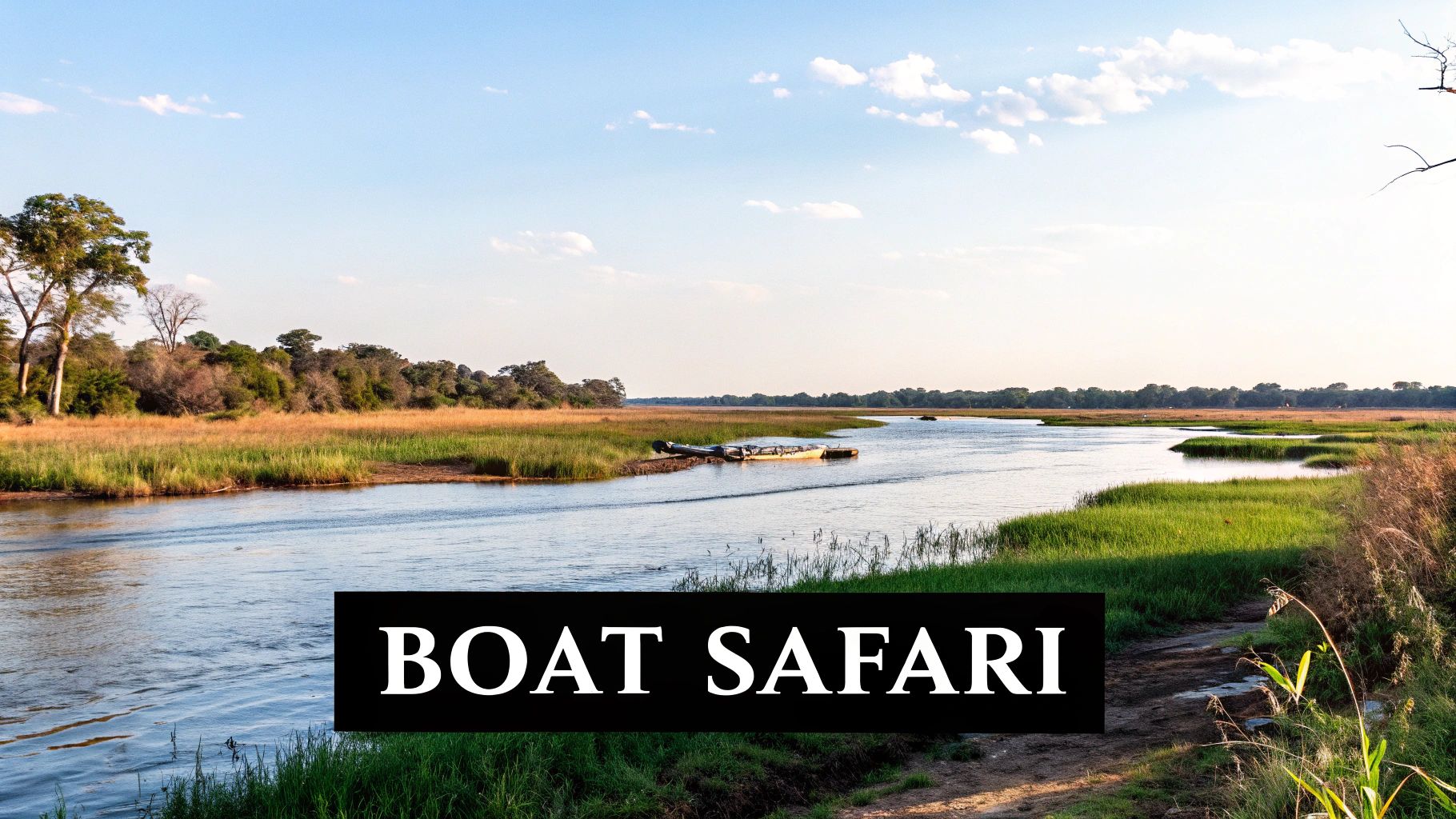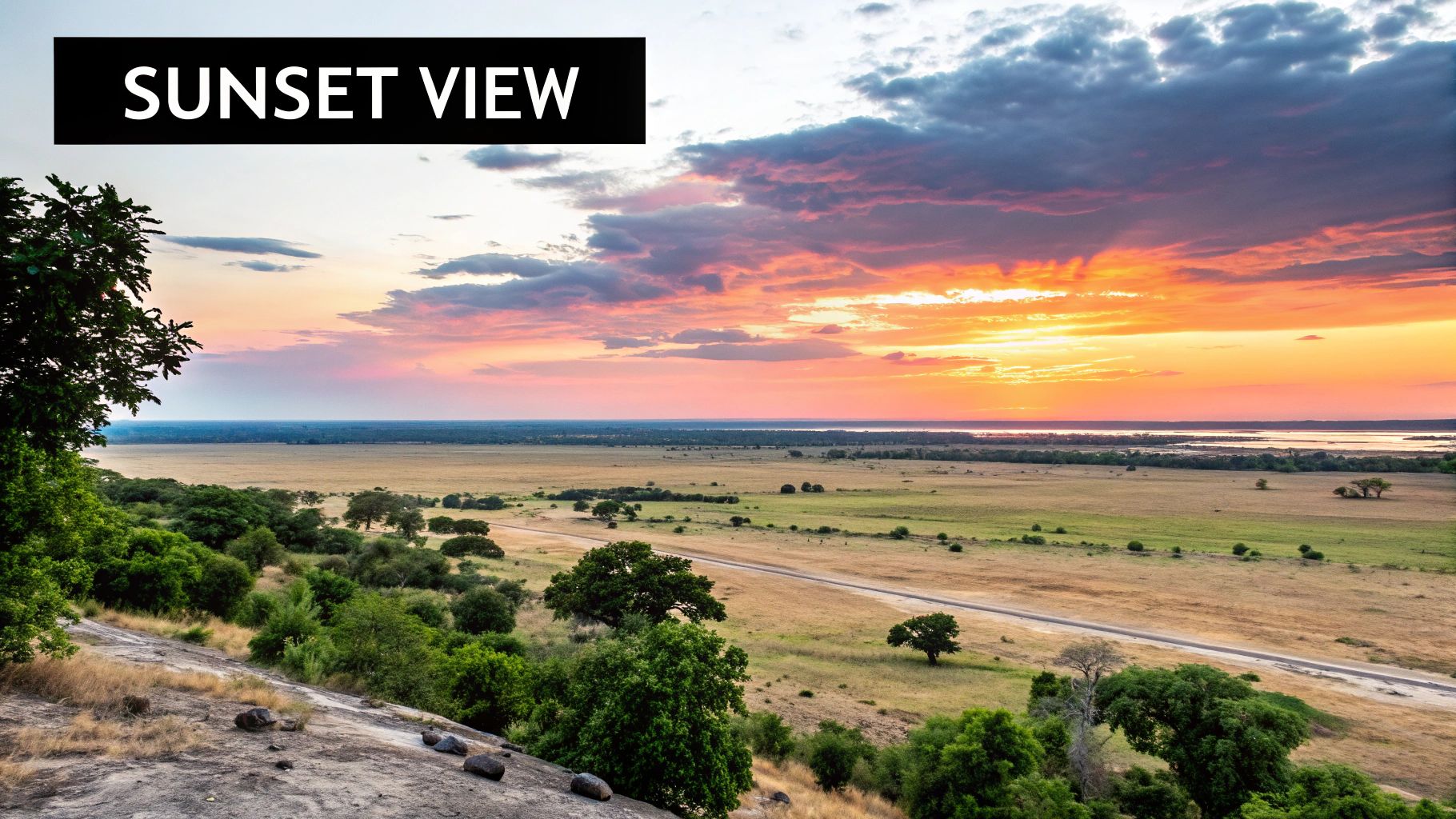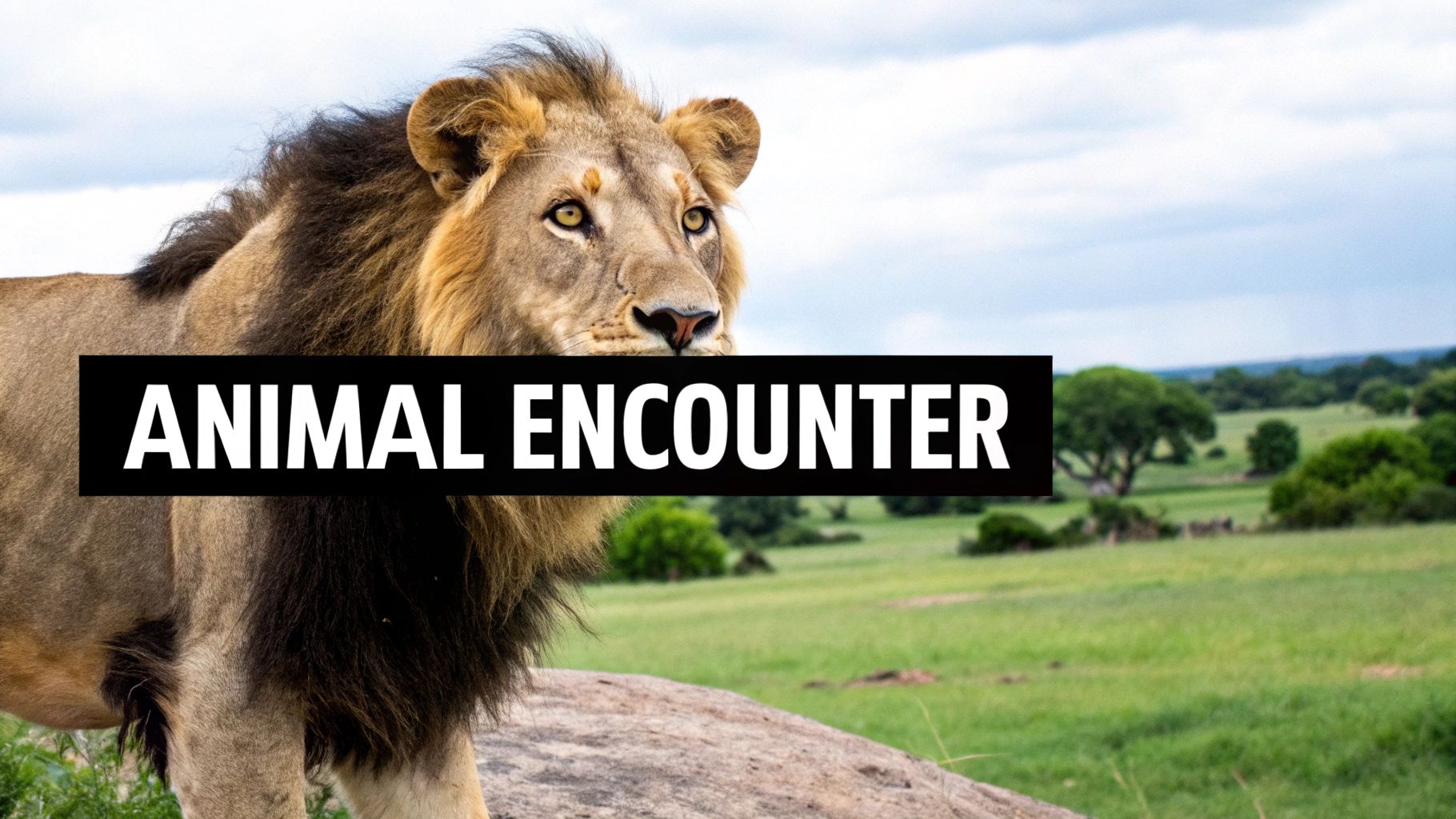Table of contents [Show]
- Why Chobe National Park Safari Stands Above the Rest
- Timing Your Chobe National Park Safari for Maximum Impact
- Chobe Safari Seasons Comparison
- Extraordinary Wildlife Encounters on Your Chobe Safari
- Beyond the Game Drive: Unforgettable Chobe Safari Activities
- Where to Stay: Accommodation That Enhances Your Safari
- Crafting Your Perfect Chobe National Park Safari Itinerary
Why Chobe National Park Safari Stands Above the Rest

A Chobe National Park safari is more than just a travel checklist item; it's an unforgettable journey into a truly special ecosystem. Botswana’s commitment to conservation makes Chobe a unique destination, offering a genuine wilderness adventure unlike any other in Africa. This dedication ensures thriving biodiversity and exceptional wildlife viewing.
This means you can observe animals behaving naturally in their habitat, undisturbed by human interference.
The Elephant Capital of Africa
Chobe isn't called the “Elephant Capital of Africa” without good reason. The park has the highest concentration of elephants on the continent, with estimates ranging from 50,000 to 130,000 elephants living in and around the park. This huge population is a major attraction for visitors, especially during the dry season (May to October) when elephants gather at the Chobe River.
Chobe Game Lodge, located right on the riverbank, provides unique electric vehicle game drives and solar-powered boat safaris for up-close views of these amazing animals. The sheer number of elephants in Chobe highlights Botswana's conservation success and truly sets the park apart. Learn more about visiting Chobe National Park here.
Diverse Habitats and Wildlife
Chobe's biodiversity goes far beyond its elephant population. The park's diverse landscapes, including the Chobe River, lush floodplains, and dry savannas, support a wide range of wildlife. Lions, leopards, African wild dogs, buffalo, and various antelope species all call Chobe home.
This habitat variety offers a wider array of animal sightings compared to parks with more uniform environments.
The Chobe River: A Lifeline for Wildlife
The Chobe River is the lifeblood of this ecosystem. It draws wildlife, especially during the dry season when water is scarce. This creates fantastic game viewing opportunities as animals congregate along the riverbanks to drink.
Boat safaris give you a unique vantage point, allowing you to watch animals from the water and witness incredible interactions between different species.
Conservation: The Key to Chobe's Success
Botswana's forward-thinking conservation policies are essential to Chobe's flourishing ecosystem. Unlike other African destinations facing poaching and habitat loss, Botswana prioritizes sustainable tourism and wildlife protection.
This commitment ensures a more authentic and enriching safari experience, where visitors can witness wildlife thriving in its natural habitat. This mindful approach guarantees that future generations will also experience the magic of Chobe.
Timing Your Chobe National Park Safari for Maximum Impact

Planning a safari in Chobe National Park? The best time to visit depends entirely on what you're hoping to see and experience. Chobe's distinct seasons offer dramatically different safari adventures. Understanding these seasonal variations will ensure you plan the perfect trip.
Dry Season: Prime Wildlife Viewing (May-October)
The dry season (May-October) is renowned for unparalleled wildlife viewing opportunities. As water sources become scarce, animals congregate around the Chobe River. This creates incredible concentrations of wildlife, making it easy to spot numerous species in a short amount of time.
Imagine massive herds of elephants drinking along the riverbanks, a truly breathtaking sight. The dry vegetation also enhances visibility, increasing your chances of seeing predators like lions and leopards. Keep in mind that the dry season is also peak tourist season, so expect higher prices and more visitors.
Green Season: Lush Landscapes and New Life (November-April)
The green season (November-April) offers a different kind of magic. The park transforms into a vibrant green paradise with the arrival of newborn animals. This is an excellent time for birdwatching, as migratory birds join the already abundant resident species.
The green season offers a more intimate safari experience with fewer crowds and lower rates. This makes it a more budget-friendly option. However, the dense foliage can sometimes make spotting wildlife a bit more challenging. Check out our guide on planning your tour for more helpful tips.
To help you decide which season is right for you, let's take a closer look at what each has to offer:
Chobe Safari Seasons Comparison
| Season | Months | Wildlife Viewing | Crowds | Rates | Weather | Activities |
|---|---|---|---|---|---|---|
| Dry Season | May - October | Excellent | High | Higher | Dry and sunny | Boat safaris, game drives |
| Green Season | November - April | Good | Low | Lower | Lush and green | Birdwatching, game drives |
This table highlights the key differences between the dry and green seasons in Chobe. As you can see, each season provides a unique perspective on the park's beauty.
The Chobe River: A Lifeline for Wildlife
The Chobe River plays a vital role in the park's ecosystem, influencing the safari experience year-round. During the dry season, it becomes a crucial water source, attracting animals from far and wide. This creates fantastic opportunities for boat safaris, offering unique perspectives on wildlife interactions.
In contrast, during the green season, rising water levels flood the surrounding floodplains, creating a vast network of waterways. This opens up new areas to explore, showcasing the park's lush vegetation and abundant birdlife.
Choosing Your Ideal Safari Time
The best time for your Chobe safari truly depends on your personal preferences. For guaranteed wildlife sightings and the excitement of larger animal concentrations, the dry season is ideal.
If you prefer a more tranquil experience with fewer crowds, and are interested in birdwatching and newborn animals, the green season offers a unique and rewarding perspective. Consider your priorities and plan your trip accordingly to maximize your Chobe experience.
Extraordinary Wildlife Encounters on Your Chobe Safari

Chobe National Park is renowned for its large herds of elephants, but it offers so much more. It's a thriving ecosystem filled with diverse wildlife and fascinating behaviors. Beyond the elephants, a closer look reveals the intricate relationships between predator and prey, unique animal adaptations, and the vital role of the Chobe River. This exploration will delve into these captivating dynamics, offering valuable insights for your Chobe National Park safari.
Predator-Prey Dynamics: A Constant Struggle For Survival
The predator-prey relationship is fundamental to Chobe's ecosystem. Lions, masters of the hunt, have adapted to hunting buffalo in daylight, a behavior rarely seen in other African parks. Witnessing these hunts, with the lions' calculated movements and the buffalo's defensive formations, is a dramatic spectacle of nature's power.
Learning to recognize the subtle signs preceding these events adds another dimension to your game drives. Alarm calls from birds or the nervous behavior of prey animals can signal an impending encounter. Being attuned to these cues allows you to anticipate and witness these thrilling moments.
The River’s Influence: A Lifeline and a Stage
The Chobe River is more than just a scenic element; it's a lifeblood that shapes wildlife behavior and distribution. It’s an essential resource that dictates how animals move between the river and the woodlands. Understanding these patterns is key to maximizing your wildlife sightings.
During the dry season, animals gather at the riverbanks to drink, providing incredible viewing opportunities. But even in the green season, the river and its tributaries are crucial, providing water and supporting fertile habitats.
Chobe’s Diverse Regions: Finding the Elusive Species
Chobe National Park comprises four distinct regions, each with unique characteristics and wildlife concentrations. While elephants are abundant throughout, some species, like the leopard and African wild dog, are more elusive. Many visitors miss these sightings due to a lack of understanding about their preferred habitats.
But with a little insider knowledge, you can significantly improve your chances. Concentrating your search in areas known for their presence, such as dense woodlands for leopards or open plains for wild dogs, increases your odds. You might be interested in: Exploring Chobe National Park Locations. The park is also a haven for birdwatchers, boasting over 450 bird species, making it a prime birding destination in Africa. September is particularly rewarding, as migratory birds return, further enriching the avian population. Discover more insights about Chobe National Park. The combination of exceptional birdlife and impressive game viewing makes a Chobe safari a truly enriching experience.
Beyond the Game Drive: Unforgettable Chobe Safari Activities

While game drives are a classic part of any Chobe National Park safari, the park's diverse landscape offers a wealth of other activities beyond the traditional four-wheel-drive experience. These unique excursions offer fresh perspectives and deeper connections with Chobe's incredible ecosystem.
Water Safaris: An Elephant's Perspective
Chobe's extensive waterways, especially the Chobe River, provide exceptional opportunities for water-based safaris. These river trips bring you remarkably close to the wildlife, allowing for intimate observation without disrupting their natural behaviors.
Elephants and hippos, often seen from a distance on land, can be observed up close as they swim and interact in the water. This vantage point unveils behaviors seldom witnessed from a vehicle, offering a truly special experience.
This unique perspective gives you a new appreciation for these magnificent animals and their aquatic abilities. For those interested in other wildlife encounters, even seemingly desolate landscapes can teem with diverse fauna. Check out the fascinating wildlife you can see at the Chobe National Park. You can also discover recent news from Chobe National Park.
Photography From the Water: Capturing the Perfect Shot
Specialized photography boats elevate the water safari experience. These boats often feature swivel seats and stabilizing equipment, enabling amateur photographers to capture professional-quality images.
Even without high-end cameras, you can secure stunning photos of wildlife in action against the beautiful backdrop of the Chobe River. These features are invaluable for capturing a kingfisher diving for a meal or a herd of elephants crossing the river. The enhanced stability allows for sharper images, even when using telephoto lenses.
Walking Safaris: Immersing Yourself in the Wilderness
For a truly immersive experience, consider a walking safari in designated areas of the park. These guided walks let you experience Chobe at a slower pace, engaging your senses in ways a vehicle-based safari can't.
The sights, sounds, and smells of the African bush become more vivid on foot, fostering a profound connection with nature. Walking safaris offer the thrill of tracking animals and discovering the intricate details of the ecosystem, from tiny insects to medicinal plants. This intimate exploration fosters a deeper understanding of the natural world.
To help you plan your Chobe adventure, we've compiled a guide to the various safari activities:
Chobe Safari Activities Guide
| Activity | Best Season | Duration | Highlights |
|---|---|---|---|
| Game Drives | All Year | 2-3 hours | Diverse wildlife sightings, predator interactions |
| Water Safaris | All Year | 2-3 hours | Close encounters with aquatic wildlife, unique perspectives |
| Photography Boat Safaris | All Year | 3-4 hours | Stabilized platform for photography, expert guidance |
| Walking Safaris | Dry Season (May-October) | 2-4 hours | Immersive bush experience, tracking wildlife, learning about flora and fauna |
This table provides a general overview. Prices and durations can vary depending on the tour operator and specific itinerary. Remember to book in advance, especially during peak season. Walking safaris provide a uniquely intimate experience with nature.
Where to Stay: Accommodation That Enhances Your Safari
Your choice of accommodation in Chobe National Park plays a crucial role in shaping your overall safari experience. It's more than just a place to rest your head; the right lodge can open doors to exceptional wildlife encounters and deepen your appreciation for this remarkable ecosystem. Let's explore the various accommodation options available and how they can influence your Chobe adventure.
Riverside Lodges: Uninterrupted Views of Nature
Riverside lodges offer breathtaking views and unparalleled opportunities for wildlife viewing, even between scheduled game drives. Picture yourself enjoying your morning coffee as elephants bathe in the river or savoring a sunset dinner while hippos emerge nearby. This constant immersion in nature truly elevates the entire safari experience.
These prime locations often grant exclusive access to private riverbanks and channels, increasing your chances of observing unique animal interactions and spontaneous sightings. This maximizes your wildlife viewing potential, providing unforgettable moments.
Location, Location, Location: Shaping Your Game Drives
The specific location of your lodge within Chobe National Park directly influences your daily game viewing routes. Some lodges are situated near the park’s entrance, offering quick access to the core game viewing areas. Others, nestled deeper within the park, provide a more secluded experience and access to less-traveled routes.
This means the type of habitat you explore and the animals you're likely to encounter can vary significantly based on your lodge's location. Choosing strategically can help you tailor your safari to specific wildlife interests, whether you're passionate about birding or eager for predator sightings.
Luxury vs. Independent: Balancing Cost and Convenience
Choosing between all-inclusive luxury lodges and independent options is a crucial step in planning your safari. Luxury lodges offer seamless convenience, encompassing all meals, activities, and transfers in a single price. However, this convenience often comes with a higher cost.
Independent options, on the other hand, provide greater flexibility and are often more budget-friendly. This approach requires you to manage your own bookings and transportation. The ideal choice hinges on your budget and preferred travel style. You might find Exploring accommodation options helpful in your research.
Community-Owned Lodges: Supporting Local Sustainability
Staying at a community-owned lodge provides a more enriching cultural experience. These lodges directly benefit local communities by generating employment and economic opportunities, fostering sustainable tourism practices.
Your stay contributes directly to the preservation of Chobe's environment and cultural heritage. It also offers opportunities to interact with local residents, learn about their traditions, and gain a deeper understanding of the region’s vibrant history.
Mobile Tented Camps: Immersion in the Wild
Mobile tented camps offer a distinctly different safari experience. While they may not offer the same amenities as permanent lodges, they provide exceptional intimacy with the wilderness.
Moving with the wildlife ensures you are always at the heart of the action, allowing for close-up encounters and the chance to experience the captivating sights and sounds of the bush at night. This immersive experience creates a unique and exhilarating connection with nature.
Crafting Your Perfect Chobe National Park Safari Itinerary
A Chobe National Park safari is a must-do for any African adventure. Planning is key to maximizing your experience in this incredible destination. A well-crafted itinerary, tailored to your interests, can elevate a standard safari into something truly unforgettable. Let's explore the essentials of planning the perfect Chobe adventure.
Beyond the Day Trip: Why Multiple Days Matter
Many try to squeeze Chobe into a single day trip from Victoria Falls. While this offers a taste of the park, it often leaves visitors wanting more. Adding even a single extra day significantly enhances the experience, allowing ample time to explore diverse areas and observe a wider range of wildlife behaviors.
This extra time offers a more relaxed pace and greater flexibility. It also increases your chances of witnessing unique animal interactions and experiencing the true heart of Chobe.
Combining Chobe with other nearby destinations, like the Okavango Delta, offers a more holistic understanding of southern African ecosystems. These regions provide contrasting landscapes and wildlife, enriching your safari experience.
For instance, the Okavango Delta's waterways are teeming with aquatic life and bird species, a perfect complement to Chobe's focus on large terrestrial mammals. This pairing provides a comprehensive view of the region’s biodiversity.
Timelines and Budgets: Planning for Different Travel Styles
The ideal length and cost of your Chobe safari depend on your preferred activities and accommodations. A basic three-day, two-night safari offers a solid introduction to the park, with time for game drives and river cruises. For deeper exploration, consider a longer itinerary including specialized activities like walking safaris or photography-focused excursions.
Chobe offers accommodation options ranging from rustic campsites to luxurious lodges. All-inclusive packages simplify planning and offer predictable pricing, while independent travel provides greater flexibility and potential cost savings. You might be interested in: Understanding page structure for better planning.
Logistics and Packing: Ensuring a Smooth Journey
Careful planning streamlines travel logistics. Consider flight connections, transfer times, and visa requirements in advance. Internal flights or road transfers connect Chobe with other destinations, requiring coordination with your accommodations and activities.
Strategic packing also enhances your safari experience. Essentials include lightweight, neutral-colored clothing, sturdy walking shoes, sunscreen, insect repellent, a wide-brimmed hat, and binoculars. A good quality camera with a telephoto lens is highly recommended for capturing stunning wildlife photos.
Creating Your Dream Safari
By considering these elements, you can create a Chobe National Park safari perfectly suited to your desires. Whether you're seeking thrilling wildlife encounters, tranquil river cruises, or an immersive bush experience, Chobe has something for everyone.
Ready for an unforgettable Chobe adventure? Book your safari with Maximum Adventure Trails and experience the magic of Botswana's wilderness. Start planning your dream safari now!

